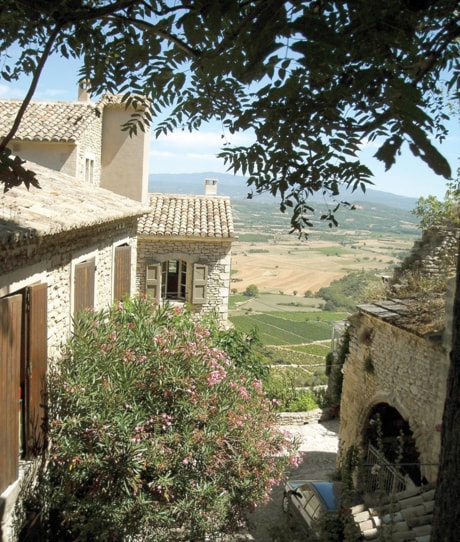MONIEUX, France — On a road trip through the south of France last summer, I hoped to find the place I’d come to love from reading Peter Mayle’s A Year in Provence and his other books. But I worried that the Provence of my dreams might be over-commercialized and overrun by tourists.
Happily I did find what I was looking for, but not always where I expected it. Yes, I went to the popular tourist jaunts — an amphitheatre built by the Romans, a farmer’s market, Paul Cezanne’s studio in Aix-en-Provence, and Arles, where Vincent Van Gogh painted.
But what made Provence so enchanting for me was a triple sensory experience for the eyes, nose and palate — the scenery, scents and food — along with a detour off the beaten path to Monieux, a small town surrounded by lavender fields.
Provence is known for beautiful landscapes of cypress and olive trees amid verdant fields, with medieval towns perched seemingly precariously on hills. Lavender scents the air. And fruits, vegetables and olive oil are so fresh you’re convinced farmers picked or produced them that day. The Cavaillon melon, which looks like a softball-sized cantaloupe and costs around two euros (just over C$3), is the most luscious melon I have ever tasted.
Guidebooks often recommend staying in a big town with good train and bus connections, such as the very Roman Avignon and Cezanne’s hometown, Aix-en-Provence. There is certainly nothing wrong with that. But to really see and feel the real Provence, stay in a small town. Rent a car and explore the country roads, which are fairly empty, even in the vacation month of August.
I felt like I’d found Mayle’s Provence in the hill town of Monieux, about 65 km east of Avignon. The minute you wake up, you smell the subtle fragrance of lavender. Houses with window shutters in cheerful pastel colours dot the town while kids on bikes greet even strangers with a friendly “bonjour” as they ride by.
My friend and I stayed at a bed and breakfast called Chez Isabelle, run by Isabelle de Monies de Sagazan. A former real estate agent from Brittany, she moved to Monieux 10 years ago to pursue the country life. She has two big bedrooms to rent out for under 50 euros per night.
Breakfast is on the patio, with a small view that overlooks lavender fields. She served six pots of homemade jams — my favourite was cherry mint — as well as breads, a homemade peach pie, cereal, juice and espresso. Watch out for the cake-loving dog named Voyou, or Hooligan, lest he swipe your pastry while you’re not looking.
We drove our tiny Peugeot to Sault, 6.5 km east of Monieux and the centre of lavender production in the area.
I brought my GPS, which has a map for most of Europe. I set it to find routes with the shortest distance, which bypassed freeways for more picturesque country roads. The GPS made our trip much more pleasant, since we avoided the stress of getting lost in a foreign country and it could find the nearest gas station in a jiffy.
We also rented a car with air conditioning, which is not in every rented vehicle but was welcome after a long trek, even though the weather was a pleasant 27-29 C most days with a cool breeze.
Gas is more expensive in Europe than in North America but our economy car used only a tank of gas for four days of travel. (One issue: stick shifts are the norm and automatic rental cars can be hard to find.)
Sault overlooks a valley of lavender fields so be sure to go during blooming season in July and August. Don’t miss the panoramic view from the village centre.
A cafe sits next to the view, where you can try lavender ice cream. On a Tuesday afternoon there, a group of men were playing petanque, a French past-time where players compete to throw metal balls toward a target ball called cochonnet.
Provence is France and yet not purely French. Italian influences abound from the Roman amphitheatre in Arles, the town where Vincent Van Gogh cut off his ear, to the Papal palace in Avignon, the seat of popes in the 14th and 15th centuries. Gelato, tiramisu and pasta are offered side-by-side with escargot, steak and frites and the regional Cotes du Rhone wines.
A dining delight is Le Bistrot du Paradou, near the medieval city of Les Baux. Chef Jean-Louis serves a set meal for 49 euros, including a bottle of the restaurant’s own wine.
We had perfectly cooked slices of red snapper as an appetizer, France’s famously flavourful Bresse chicken for the entree, a plate of cheeses including the smelly but delectable Normandy epoisse and dessert.
Even the olive oil was so fragrant that we couldn’t stop sopping it up with our bread.
